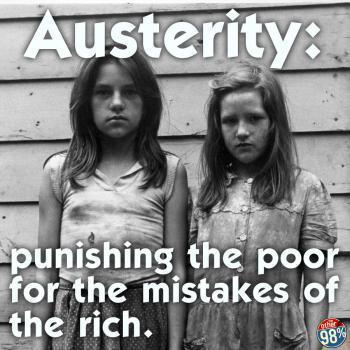Alesina’s ‘expansionary austerity’ — a tale of scientific delusion Alberto Alesina has returned to the debate on budget deficits, austerity, and growth … Now, with fellow economists Carlo Favero and Francesco Giavazzi, Alesina has written a new book entitled Austerity: When It Works and When It Doesn’t … New book, old tune. The authors’ conclusion, in a nutshell, is that “in certain cases the direct output cost of spending cuts is more than compensated for by increases in other components of aggregate demand.” The implication is that austerity – cutting the budget deficit, not expanding it – may well be the right policy in a recession … Alesina’s theory rests on two conceptual pillars. The main one is that if deficits persist, businesses and consumers
Topics:
Lars Pålsson Syll considers the following as important: Economics
This could be interesting, too:
Lars Pålsson Syll writes Schuldenbremse bye bye
Lars Pålsson Syll writes What’s wrong with economics — a primer
Lars Pålsson Syll writes Krigskeynesianismens återkomst
Lars Pålsson Syll writes Finding Eigenvalues and Eigenvectors (student stuff)
Alesina’s ‘expansionary austerity’ — a tale of scientific delusion
Alberto Alesina has returned to the debate on budget deficits, austerity, and growth … Now, with fellow economists Carlo Favero and Francesco Giavazzi, Alesina has written a new book entitled Austerity: When It Works and When It Doesn’t …
New book, old tune. The authors’ conclusion, in a nutshell, is that “in certain cases the direct output cost of spending cuts is more than compensated for by increases in other components of aggregate demand.” The implication is that austerity – cutting the budget deficit, not expanding it – may well be the right policy in a recession …
Alesina’s theory rests on two conceptual pillars. The main one is that if deficits persist, businesses and consumers will expect higher taxes and will therefore invest and consume less … The second, supplementary pillar is the assumption that rising public debt leads investors to expect a default …
This supplementary case cannot be regarded as a general rule. If a country has its own central bank and issues its own currency, the government can cause interest rates to be whatever it wants them to be by ordering the central bank to print money. In this case, low interest rates will be the result not of austerity, but rather of monetary expansion …
So we are left with Alesina’s main pillar: a credible commitment to public spending cuts today will boost output by removing the expectation of higher taxes tomorrow.
As we all know there has been an obsession with government budget deficits since the crisis of 2008. Alesina’s ideas — mostly building, as apostrophised by Skidelsky, on non-convincing econometric alchemy — about austerity expansion basically boils down to the hope that if you cut deficits, the confidence fairy will make business people invest.
No matter how much confidence you have in the policies pursued by authorities nowadays, it cannot turn bad austerity policies into good job creating policies. Austerity measures and overzealous and simple-minded fixation on monetary measures and inflation are not what it takes to get our limping economies out of their present-day limbo.  The austerity delusion simply do not get us out of the ‘magneto trouble’ — and neither does budget deficit discussions where economists and politicians seem to think that cutting government budgets would help us out of recessions and slumps. In a situation where monetary policies have become more and more decrepit, the solution is not fiscal austerity, but fiscal expansion!
The austerity delusion simply do not get us out of the ‘magneto trouble’ — and neither does budget deficit discussions where economists and politicians seem to think that cutting government budgets would help us out of recessions and slumps. In a situation where monetary policies have become more and more decrepit, the solution is not fiscal austerity, but fiscal expansion!
We are not going to get out of the present economic doldrums as long as we continue to be obsessed with the insane idea that austerity is the universal medicine. When an economy is already hanging on the ropes, you can’t just cut government spendings. Cutting government expenditures reduces aggregate demand. Lower aggregate demand means lower tax revenues. Lower tax revenues mean increased deficits — and calls for even more austerity. And so on, and so on …
Economists have a tendency to get enthralled by their own theories and models, and forget that behind the figures and abstractions there is a real world with real people. Real people that have to pay dearly for fundamentally flawed doctrines and recommendations.
